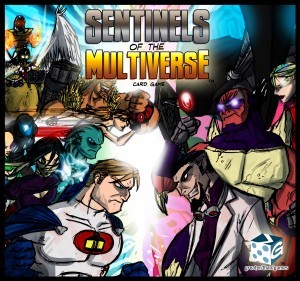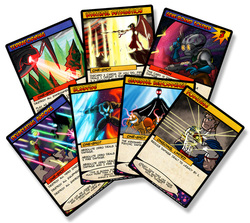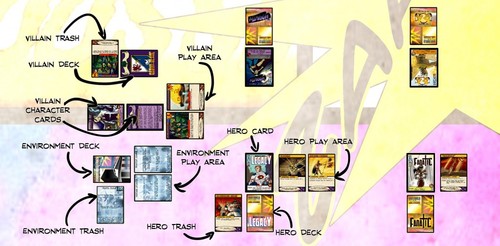
I may be required to relinquish my nerd membership card for saying this, but I have never really been able to get into comic books. There was a time when I was a kid that I had a passing interest; mostly through the exquisite Frank Miller limited series “The Dark Knight Returns”, and I’m probably dating myself by admitting that, but I really haven’t experienced comic books since then. It’s definitely not for lack of desire, but whenever confronted with the overwhelming number of reboots, spinoffs, story arcs, crossovers, and alternate universes found in comics today, my eyes tend to glaze over trying to figure out where to start, and I decide that tackling the rules to Advanced Squad Leader may be a simpler proposition.
However, even though I am not a comic book enthusiast, I am not oblivious to the worlds and characters that live inside their pages. Superheroes have taken a firm grip on American culture (and more so in geek culture specifically), and no mere mortal has the power to wrest it free. Every year brings new blockbuster movies featuring superheroes, antiheroes, villains, and vermin straight from the comics. Music and literature reference comics, and pay homage to them by building on their familiar themes and character archetypes. This cultural love of comic books is not a new development, either; half of a century after the first comics were produced, superheroes and adventure filled my childhood, as I sat in Spiderman Underoos, glued to the television during the magic that was Saturday morning cartoons.
Despite this saturation of superheroes in the media, I am aware that my knowledge of the comic hobby is analogous to someone who immediately thinks “Monopoly”, when I mention my board game hobby. It was for this reason that I was a bit hesitant when I picked up Sentinels of the Multiverse, the first release from the indie publisher Greater Than Games. I was concerned that maybe I wouldn’t “get” the game, or that the theme would fall flat, because I didn’t have the background to fully understand it. I am happy to say, however, that my concerns were unfounded, and I had quite a lot of fun playing Sentinels of the Multiverse.
The Game:
Sentinels of the Multiverse is a cooperative card based game set in a fictional world of superheroes and villains. Full of tongue-in-cheek humor, it embraces the multitude of different types of environments, heroes, and villains found in comics. Sentinels of the Multiverse does not work too hard to tie these environments and characters together into a cohesive world, but this juxtaposition of characters and locations is where much of the game's enjoyment comes from. Heroes may find themselves under the waters in the lost city of Atlantis, or battling evils on an abandoned base on mars; or facing off with villains that range from the sci-fi themed alien space conqueror “Grand Warlord Voss”, to the communist threat of “Citizen Dawn”, and her legion of art deco minions that hearken back to the Red Scare.
Players can choose from 10 different heroes to be their personal warrior of justice. Each character is loosely based on a popular comic book archetype with character selections like: “The Wraith” – a child of wealthy corporate parents, who uses her arsenal of gadgets to get the job done, and serves as homage to another rich comic book gadgeteer who identifies with flying rodents; or “Legacy” – who’s ancestor’s brush with Paul Revere, brought lanterns and a magic ring into his heritage, and shares some passing similarities with another superhero who may just be green wit h envy. The heroes in Sentinels of the Multiverse do not pose as cheap clones of famous comic book characters, but instead feel like they were lovingly crafted as a celebration of comic books. They contain a tongue in cheek humor, and a wry acknowledgement of the sometimes ridiculous, but greatly entertaining nature of comic book heroes - and never cross that line into caricature.
h envy. The heroes in Sentinels of the Multiverse do not pose as cheap clones of famous comic book characters, but instead feel like they were lovingly crafted as a celebration of comic books. They contain a tongue in cheek humor, and a wry acknowledgement of the sometimes ridiculous, but greatly entertaining nature of comic book heroes - and never cross that line into caricature.
I really like the art in Sentinels of the Multiverse, it has an approachable, fun and colorful style with a very unique graphic design. It is sometimes a gamble to heavily theme components, and still keep them readable and usable, but Sentinels of the Multiverse really succeeds here. Each character card is designed to look like the cover of a comic book, with the character's hit points replacing the issue number. These playful illustrations really radiate personality, express a sense of motion, and kindle the desire to play different characters to see what they have to offer.
In Sentinels of the Multiverse, there are 3 distinct forces that are in constant battle with each other: The heroes, the villain, and the environment itself. Each hero, environment, and villain is represented by a deck of cards that has been specifically tailored to encompass the essence of that character. These decks are designed to represent the strengths, weaknesses, and personality of each individual character, or environment. In many ways, the environments of Sentinels of the Multiverse are like characters themselves, each with a unique feel and personality. In the game world, the villain is attempting to destroy the heroes, while the heroes are working to bring justice to the villain, but the environment acts as a neutral, chaotic force, bringing help and harm to villain and hero alike. If the heroes can harness the environment to their advantage, it can work as a powerful ally, but it can turn just as quickly, and bring a dinosaur filled, prehistoric death upon them.
Gameplay:
Play begins with the players choosing a Villain to battle. The villain's two double sided character cards are then placed onto the play area. These cards explain the villain's behavior, special powers, and initial setup instructions, including which side of the card to place face-up. This is important because like any good villain, the bad guys in Sentinels of the Multiverse are not one-sided. At some point during the game, an event will trigger the villain to flip its card over to the reverse side. This second side has a set of different behaviors and powers that the villain will perform. This is a really neat mechanic, and adds depth to the villain characters, as gameplay changes, to give a nice dynamic tension to gameplay. A villain card can flip over multiple times over the course of a battle, making battle feel like an epic tug-of-war, and adding an extra layer of strategy to the game, as the heroes can make choices which influence the aspect of the villain they are battling. Although the villain is not controlled by a player, and his behaviors are dictated by the rules on his card, he has enough personality that it's hard not to see him as a living adversary.
The villain starts off each turn by performing any pre-turn actions on his cards, and then drawing, and playing the top card from his deck, which is filled with an assortment of minions and special powers. After that, the villain and any of his minions in play resolve the effects printed on their cards. These effects can vary, either helping the villain and other minions, or damaging the heroes. Even when damaging the heroes, different minions behave in different ways. Some may target the hero with the least amount of health, while others attack the hero with the most health. This makes for some interesting decision making on the heroes turn when it comes time to choose which enemy to dispatch. The decision can be both a puzzle and a gamble, because the player with the lowest or highest health can easily change from round to round.
After the villain’s turn, each player gets the opportunity to shake things up. Each hero takes his full turn in-order, before play passes to the next hero. At the start of the hero turn, the player gets the opportunity to play a card from his hand to the table. These cards come in different flavors, some take effect immediately, while others persist until they are destroyed.
Once the hero has played a card, he has the opportunity to use one of his powers. Each hero has a default power printed on his character card, but cards that he plays to the table can give him a more diverse selection. Powers can do different types of damage, such as fire, ice, melee, and projectile among many others. Since many enemies have certain resistances, choosing what kind of damage to do can be just as important as choosing who to attack. Some hero powers also grant healing abilities, allowing a return from a harrowing brush with death. Many of the cards in the hero's play area work together in a very specific way to create some interesting combos. Since each deck is different, it can take a few plays to learn what powers to activate in given scenarios, but when it clicks, it's a lot of fun. In addition, each hero has very different strengths and weaknesses, so to truly excel at the game, players really do have to cooperate, and play their roles effectively.
After the hero has used his power, he draws a card from his deck and play moves to the next hero. If for some reason a hero has not played a card, or used a power, he gets the opportunity to draw an additional card at this end step.
After all the heroes have taken their turn, it's the environments turn to cause some chaos. Each of the 4 unique environments has it's own deck of cards that can help or hinder the players. The interesting thing about the environment deck, is that it has the potential to affect any characters in play, villain and hero alike. This means that players can manipulate the play-field, and use the environment to their advantage. For example, an environment card may do damage to the character with the lowest number of hit points, and knowing this, the heroes may decide to keep that card in play, allowing the environment to destroy an ailing enemy target, and focusing their attacks on a more intimidating foe. Using the environment this way adds a surprising amount of depth and character to the game.
Most cards in the game have a health value printed onto them. When a card is attacked, it's hit points are decreased by the amount of damage dealt. This is not only true for the players and the villain, but for the environment as well. As the battle wages on, the hit points of various cards on the table will change. It is inevitable that some will be reduced to 0, in which case they are destroyed. If the villian is destroyed, the game is over, and the heroes win, but if a hero is destroyed, the player is not completely eliminated from the game, instead his character card is turned over, and a new list of actions becomes available to him. Although he is unable to draw cards or use direct powers, he can use his new actions to help his fellow players, by giving them special perks, such as the ability draw more cards, or use more powers. This lessens the impact of player elimination, while still allowing the players to experience the drama of losing a player.
Conclusion:
Sentinels of the Multiverse is surprisingly fun, I enjoyed it a lot, and my two teens have asked to play it again several times. It is an extremely approachable game with a lot of character, and more depth than I had originally anticipated. The rules are very simple, and most of the complexity of the came comes out through the way the cards interact with each other. Some character decks take some time to learn to use effectively, but the enjoyment increases when things really start to click. My daughter played a hero in a robotic suit who had no way to do direct damage, but instead had to damage herself, and allow the various cards on the table to combo in such a way that it would ultimately damage the enemy, or heal her, or both. I thought that this mechanic was very creative, and I could see my daughter's eyes light up when she finally got it, and started building her damage dealing engine.
Sentinels of the Multiverse is not without drawbacks, it has a very specific sweet spot when it comes to the number of players. Although it is billed as supporting from two to five players, it really needs to be played with three to four. Sentinels of the Multiverse does not have any self-balancing mechanic when the player numbers change; most co-op games have a mechanic that occurs on every player turn which scales difficulty, and Sentinels of the Multiverse lacks this. I'm sure that variant rules for different player counts could bring the game back in balance, by allowing players to utilize more than one hero, or requiring the villain to "power up" and perform his turn after x number of hero turns. It would have been nice to see some more polish in this area, though.
Another aspect of gameplay that was a bit frustrating was keeping track of the hit points of various cards. I started out with a handful of ten sided dice to use as health markers, but after five minutes of play, I would undoubtedly run out. The heroes and villains have enough hit points that using counters would be unwieldy, but the environment and minion cards are so numerous, and have such a small number of hit points, that counters seem more appropriate. While I don't mind using my own counters, the wide spread of values that needed to be represented could make it difficult to easily build a home-brew solution. I just pilfered parts from other games in my collection, but a casual gamer without an underground game cave may find this lack of components frustrating. A single sheet of die cut tokens with a range of values printed on them would have completely alleviated the issue.
When looking at the size of the box, and the retail price point of $39.95, some may start to cry foul, but in the case of Sentinels of the Multiverse you can't judge a book by it's cover. While the box is similar in size to a smaller card game, it actually contains more cards in it than the card heavy game Dominion, and at a lower retail price. Collectors like me who have sacrificed entire shelves for the mostly empty space in these big box card games will really appreciate the conservative packaging of Sentinels of the Multiverse.
All in all, Sentinels of the Multiverse is a solid offering with a lot of personality, fun gameplay, and a theme that works surprisingly well. Although it leans towards the lighter side of the game spectrum, there is enough depth layered in the cards for it to be enjoyed by grizzled gamers, while still remaining accessible to non-gamers. It's comic theme is not intimidating, and battles are reminiscent of the epic roller-coasters that grace the giant screens of Hollywood blockbusters. If you consistently have 3-4 players who enjoy cooperative games, and want to kick evil's ass, then support this new publisher, and pick up a copy of Sentinels of the Multiverse.
